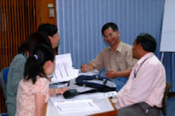Engaging the participants

Do you want to improve participation in your classroom? The simple suggestions listed below are a few ways to get participants more involved in class.
Suggestions |
Reason |
Use teamsDivide the group into teams of 4-6 members (any more than this and participation within the group will suffer). |
Teams encourage interaction between group members. Teams when used properly add a friendly rivalry that encourages greater involvement. |
Team quizzes and activitiesDesign questions or activities that test learning and recall on a team basis. Team members discuss the answer or challenge amongst themselves before answering or responding as a team. Give a score for each team’s performance in various tests and/or exercises. Keep track of scores — e.g., a tally sheet on the wall. Give a small prize afterwards. Teams can remain the same for an entire course, or change (e.g., each week). |
Friendly competition and prizes add an element of fun and excitement. By discussing responses within a group, participants can share and learn from each other — this increases people’s involvement in the activities. Creating teams improves ownership, accountabilities and responsibilities. |
Introduce speakersAt the beginning of a session, one of the participants introduces the speaker (this should be brief — e.g., name, job title, topic to be presented, experience relevant to the topic). |
Involves the participants and helps their public speaking. Also improves research skills as they have to discover interesting things about the speakers. |
Summarize previous day’s activitiesAt the beginning of each day, one of the participants gives a brief summary of the previous day’s activities — e.g., topics covered, relevance to overall course, highlights. Have a strict time limit (e.g., 5 minutes). |
Involves participants and helps public speaking and ability to summarize. Shows how a properly planned course is actually a series of related activities that build upon each other. |
Training facilitiesAssign a team to make sure training facilities and necessary equipment are in good order before and after each session. Assign a different team each day. |
Improves participants’ training management skills. Also ensures smooth operation of the equipment and suitability of the training venue. |
Class summaryJust after an activity finishes, a team or team member leads a short discussion and analysis. What was the activity’s aim? What was done? What was learned? |
People learn more effectively if they share the lessons they have learned while the activity is fresh in their minds. |
Awards and prizesGive awards to teams that perform well in various activities. Try to give at least one prize or award to every team. |
Provides incentive to do jobs well. Recognizes efforts toward team building and contributions to the success of the training. You can encourage better responses and actions by positively reinforcing good behavior. |
Group dynamicsA team or team member can lead a relevant “group dynamic” exercise (e.g., lateral thinking, team building, energizer).Note: This takes extra effort because the team or team member needs a small amount of training to learn how to lead the activity. |
Improves planning, leadership and facilitation skills, and bonding between participants. Make sure that group dynamics exercises are relevant to the topic that follows them — this ensures that participants are ready to learn. Be sensitive to cultural differences. |